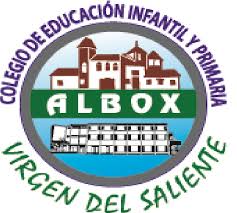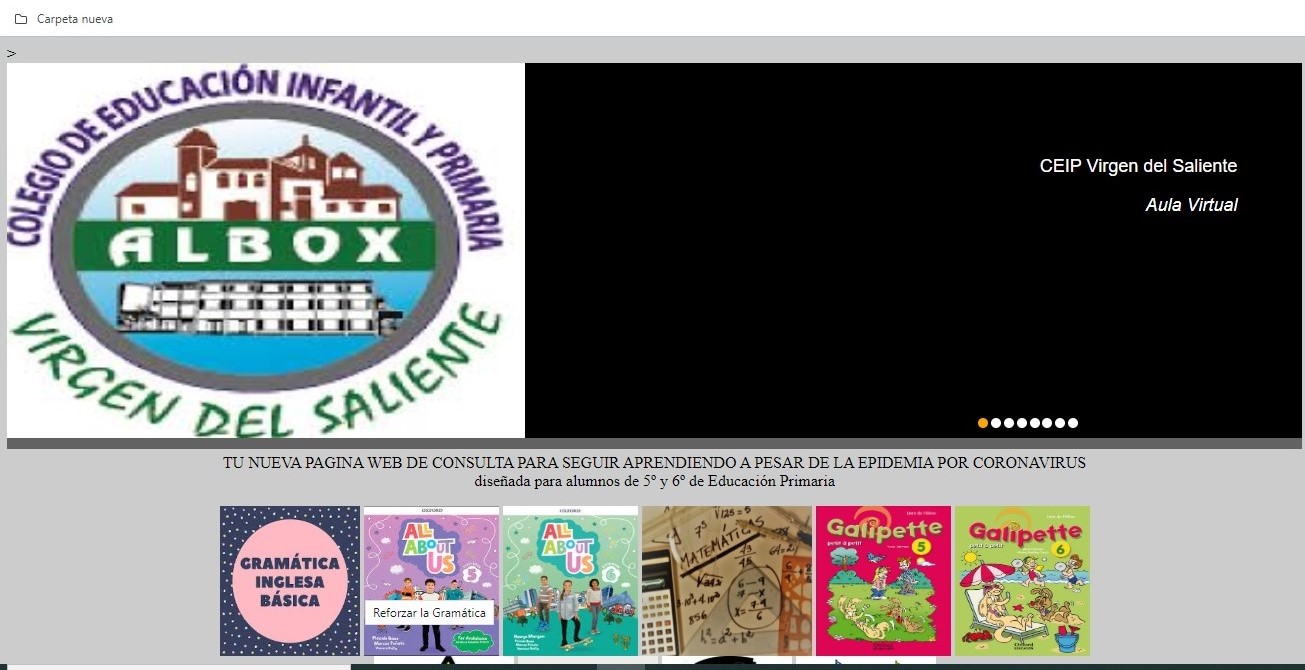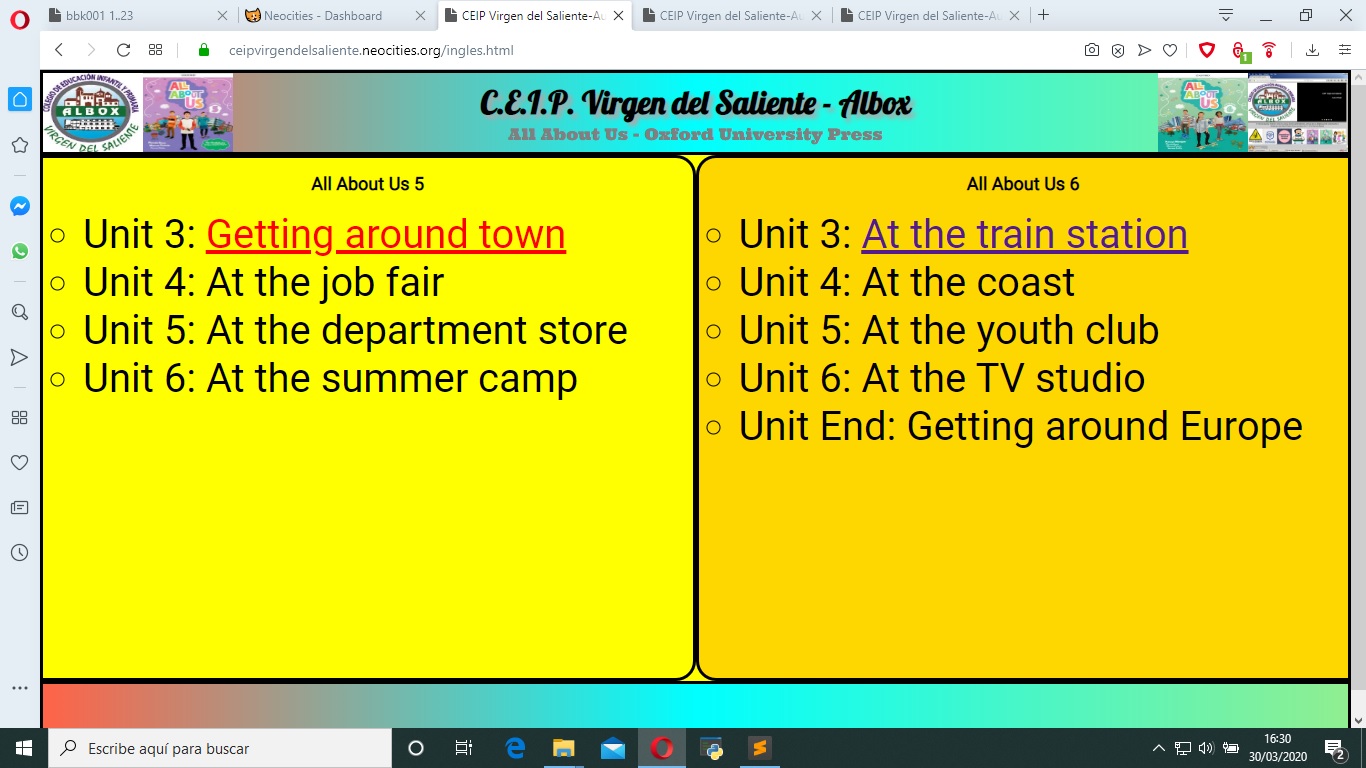Unit 2: In the countryside
Lesson 1: Vocabulary (page 16)
1. Watch, read and understand.
Visita la página de Gramática Básica y estudia el pasado del verbo to be, there was/were, adjetivos y el futuro inmediato (Be going to + infinitivo) . Haz las actividades. Después trata de comprender el diálogo del vídeo.
Daisy: Hi! I’m going to go to the countryside today with Zoe and Peter. We’re going to go mountain biking near a beautiful village and a river.
Daisy: Zoe! Peter! Are you ready?
Peter: Yes, we’re ready.
Zoe : It’s going to be great. Let’s go!
2. Listen and repeat the vocabulary
Dictation. On your notebook, write the words you hear and check your answers looking at the book
Dictado. En tu cuaderno, escribe las palabras del audio y comprueba tus respuestas mirando el libro.
3. Listening to the audio and looking at the picture on page 16, find out which number the speaker is saying.
Escuchando el audio y mirando el dibujo de la página 16, averigua el número.
4. Copy the sentences on your notebook and write the activity.
5. ACTIVIDAD EDMODO: Can you describe your town or your village? Write about it in no more than 5 lines
Lesson 2: Grammar (page 17)
1. Comparison of adjectives.
Visit BASIC GRAMMAR: Comparative Adjectives, Past Simple and Irregular Verbs and try to understand the activity 2 on this page.
En la página de GRAMÁTICA BÁSICA, accede a los apartados Grados del Adjetivo: Comparativo; Pasado Regular y Pasado Irregular y haz sus Actividades para entender el cuadro de la actividad 2.
2. Listen and read. Try to answer: Why were Mum and Dad happier in the past?
ACTIVIDAD EVALUABLE EN EDMODO: La respuesta a esta pregunta.
Escucha varias veces mirando el texto y léelo después.
3. The park game. Write how the parks are in activity 3.
ACTIVIDAD EVALUABLE EN EDMODO: Mirando la tabla de la actividad 3, escribe las características de cada parque comparando un parque con el otro.
Lesson 3: Culture (page 18)
1. Watch, What places can you see?
Observa y dí ¿Qué lugares puedes ver?
Culture film:
There are great ways to explore the countryside. These children are exploring a forest. They’re looking for birds. Look! A bird’s nest! They are very quiet near the nest. They don’t want to frighten the bird or the chicks. They take photos of the birds they see.
Treasure hunts are a fantastic outdoor activity, too. You can do a treasure hunt in a town or in the countryside. Look, these children are doing a treasure hunt in a town.
They’ve got a clue. The clue says, find the bank next to the cake shop. What’s opposite the bank? There’s the bank. There’s a beautiful park opposite the bank. It’s less crowded than the street, but it’s also very big.
Where’s the next clue? Look! There it is! It’s on the big tree. This clue says, find the river behind the big tree. Find the old, brown bridge over the river So they have to find a historical bridge. Here’s a bridge but it’s more red than brown. They’re following the river to find the next bridge. It’s more relaxing here than in the town. Yes! They did it! There’s the old, brown bridge.
I think they’ve found the last clue. It says: "Cross the bridge over the river. Turn left. Turn right. Then look in front of you". Ah! It’s the treasure. A dinosaur!
Geocaching is a like a modern treasure hunt. You look at a website to find directions and a map. You follow the directions to find the treasure. You can use a GPS like these children … or you can use a smart phone. The treasure – ‘the cache’ – is in a box.
Ooh look, a spotty plastic ring. You have to write a message in the book and put it back in the box. But you have to put something else in the box, too … And then put it back so other people can find it. You can go geocaching all over the world. Try it!
Answer the questions at the end of the video.
Traduce el texto del vídeo a español. Así, lo entenderás mejor.
2. Listen and try to answer: Why is geocaching more modern than a treasure hunt? ¿Qué significa esta pregunta?
What does Clara find on the beach? ¿Y ésta?
Ve al apartado de GRAMÁTICA BÁSICA y repasa: Verbos to be y to have, Adjetivos, Presente Simple, Pasado Simple.
ACTIVIDAD EDMODO: Responde en inglés a las dos preguntas anteriores.
Watch carefully and practice the dialogue.
Reproduce varias veces el vídeo y practica el diálogo.
Traduce al español la conversación entre estos alumnos.
Lesson 4: Cross curricular (page 19)
Watch the video and:
Look for the meaning of these words in Spanish: landscape, plain, waterfalls, valleys, peninsula, island.
ACTIVIDAD EDMODO: The video says that there are seven continents. Can you name them?
Do the quiz at the end of the video.
ACTIVIDAD EDMODO: Responde en inglés a las preguntas del ejercicio 3, página 19.
Lesson 5: Story (pages 20 and 21)
First, watch the story: The skiing snowman. Then, look at the comic in your book.
PAGE 21
Act. 3 Write the sentences in order.Act. 4 Listen to Daisy and her friends. Then, copy the questions on your notebook and answer them.
Lesson 7: Song and skills (page 23)
Enjoy the song: "Mountain biking".
Disfruta la canción: "Montando en bici por la montaña".
Ve a GRAMÁTICA BÁSICA y repasa: comparación de Adjetivos Comparative and Superlative, adverbios de frecuencia Frecuency Adverbs.
Peter: Hey, Daisy! I’ve got the best new song for your vlog.
Daisy: Fantastic! Hello, everyone. What’s your new song about, Peter?
Peter: Today’s song is about mountain biking. I think that mountain biking is the most exciting sport.
Daisy: Me, too. But is your song the most exciting song, Peter?
Peter: Of course it is!
Daisy: Listen to this
Listen and repeat.
Listen and repeat the tongue twister.
Lesson 8: Language Review (page 24)
Listen to Daisy and her friends. Which 6 adjectives are mentioned?
famous - crowded - difficult - modern - beautiful - frightening
expensive - historical - relaxing - exciting - boring - easy
Activity 2. Listen again. Read and choose.
Lesson 9: Comprehension (page 25) and Conversation (page 84)
Listen to Daisy and her friends. Which 4 places do they mention?
shops - castles - lakes - beaches - palaces - mountains - valleys - hotels





